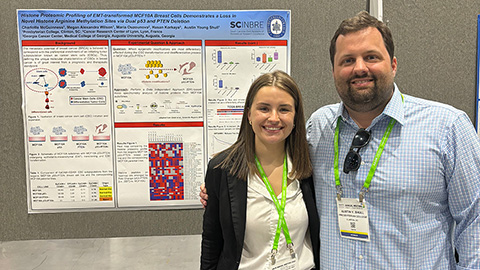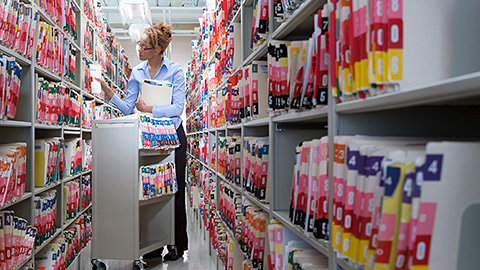Bridging the gap between research and treatment
I found the papers on PubMed six months too late. It was July 2008, and my mom, after having received the news that she was in “complete pharmacological remission” a month prior, had just been diagnosed with multiple brain metastases from triple-negative breast cancer. The papers I found showed that TNBC was much more likely to metastasize to the brain than other forms of breast cancer. If I had seen these reports sooner, I would have demanded that my mom get a brain MRI, and maybe they would have caught it sooner. My mom died on Sept. 1 at the age of 53.
 Michelle Gumz is shown in her lab at the University of Florida where she researches molecular circadian control of renal function.Courtesy of Jesse Jones/University of Florida Health
Michelle Gumz is shown in her lab at the University of Florida where she researches molecular circadian control of renal function.Courtesy of Jesse Jones/University of Florida Health
I have since made peace with the fact that I couldn’t save my mom. I did take an important lesson from this tragedy.
My mom’s initial diagnosis came just six months after I had a radical hysterectomy for a rare form of cancer. Having completed postdoctoral training in cancer biology in 2006, my anxiety levels were through the roof. I remembered quite well the molecular biology horror show that is a cancer cell. Although my lymph nodes had come back clear and I didn’t require additional therapy beyond surgery, I worried about the clonal theory — that just one cell might be hiding somewhere and would later result in a recurrence. My cancer was stage IB, and all of my doctors assured me the chance of a recurrence was extremely remote.
Following her breast cancer diagnosis, I assured my mom she would be fine. There are targeted therapies for breast cancer, I told her. If you have to have cancer, this is the kind you want, I tried to comfort her. The TNBC diagnosis came a month later. I had never heard of it. There was no targeted therapy.
Still, I made a conscious decision to trust my mom’s doctor. She was being treated at a premier cancer hospital, ranked in the top 20 nationally, and we were sure she was in the best hands.
Her oncologist was surprised at the brain metastasis articles I found in PubMed, because the prevailing understanding at the time was that Her2neu-positive tumors were the “worst” type of breast cancer. My mom received the neoadjuvant standard-of-care treatment at the time: doxorubicin, cyclophosphamide and paclitaxel. She could feel the tumor shrinking on a weekly basis, and her doctor assured us the treatment course was going well. We celebrated after her surgery when she was given a clean bill of health.
The blinding headaches, inexplicable vomiting and debilitating pain in her limbs began just a few weeks later. Looking back, I know these were clear signs of CNS involvement, yet her doctors assured her she was just experiencing the aftereffects of the chemotherapy leaving her system.
By the time she had a brain MRI, it was too late. Despite receiving whole-brain radiotherapy in addition to intrathecal chemotherapy for seven metastatic lesions on her brain, my mom went on hospice toward the end of August 2008 and died a short time later.
We will never know if a brain MRI early on would have saved my mom’s life. What I do know is that physicians can’t know everything there is to know about each subtype of each of the diseases they are treating. Although they are trained to tailor treatment for individual patients, physicians operate within guidelines that are based on established, population-level data rather than the very latest findings from basic and clinical research.
Doctors increasingly spend more and more time fighting insurance companies and seeing as many patients as possible due to decreasing reimbursement rates, making it impossible to stay on top of the very latest advances that haven’t yet made their way into clinical practice guidelines.
They need our help.
Nothing can bring my mom back, but after her death I vowed that I would never again bury my head in the sand instead of using my training to investigate the most recent findings in medicine on behalf of my loved ones.
I lucked out with an amazing oncologist when my cancer recurred in 2011. He had done postdoctoral training at the National Institutes of Health and was truly an outside-the-box thinker. At first, none of my other doctors agreed with his plan for me. He argued that my cancer was unusual and needed to be treated as such. I received truly personalized medicine before that phrase became popular. I firmly believe I am alive today because of it. A year or two later, I ran into one of the doctors who had argued that all I needed was standard-of-care treatment. That doctor was obviously surprised to see that I was alive and well.
My novel course of treatment included a chemotherapy regimen very similar to what is used for ovarian cancer. I received carboplatin plus Taxotere in a sandwich design bracketing the standard-of-care treatment, which at the time was cisplatin plus radiotherapy.
 In this family photo taken in November 2007, Michelle Gumz sits between her mother, Mary Lou “NuNu” Miller, on the left, and her sister, Melanie Lindquist. The three women were diagnosed at different times with different forms of cancer.Courtesy of michelle gumz During my treatment, my oncologist set me up on a “chemo date” with a woman fighting ovarian cancer who was close to my age. We were the youngest people in the infusion center, and we became fast friends.
In this family photo taken in November 2007, Michelle Gumz sits between her mother, Mary Lou “NuNu” Miller, on the left, and her sister, Melanie Lindquist. The three women were diagnosed at different times with different forms of cancer.Courtesy of michelle gumz During my treatment, my oncologist set me up on a “chemo date” with a woman fighting ovarian cancer who was close to my age. We were the youngest people in the infusion center, and we became fast friends.
After our physician-scientist oncologist retired, my friend had to switch to a different oncologist who was, unfortunately, an inside-the-box thinker. When my friend’s ovarian cancer recurred, the only option her team offered was doxorubicin, which is considered a drug of last resort for that type of cancer and is associated with severe side effects that drastically reduce quality of life. I reached out to a former colleague working in industry drug development for female cancers and learned about the newly approved PARP inhibitor oliparib, sold as Lynparza.
Had my friend received the doxorubicin regimen, according to the population-level outcomes, she would have been expected to have about 12 months to live. Although her medical team never even mentioned the availability of a brand-new FDA-approved drug with outstanding clinical trial results, she asked for and received Lynparza, which she qualified for due to her BRCA status and previous response to other therapies. Two years later, her disease is stable and she is enjoying a full life. She did her own research and basically demanded that she receive personalized medical treatment.
As scientists, this is something we can help our friends and family with. For the lay public, the difference between a Google search and a PubMed search may mean the difference between spiraling into a morass of misinformation on nonmedical and nonscientific websites versus accessing the most recent state-of-the-art findings at the forefront of medical research.
Cancer hit close to home once again last summer with my sister’s diagnosis of a rare form of uterine cancer. I went to the literature to check the treatments she was being offered, and I reached out to my former colleagues in cancer research and my wider network from my own training period. What I found was that my sister was being offered the best possible treatment course. I traded PubMed articles with my sister’s oncologist, who was perhaps not overly thrilled at my involvement, but I needed to do my due diligence.
As a principal investigator of a biomedical research lab, I emphasize the importance of networking for the career development of my students and postdoctoral trainees. This was an important part of my own training, and although I never doubted the importance of my network for the advancement of my career, I never imagined how important that network would become in terms of its lifesaving potential.
Enjoy reading ASBMB Today?
Become a member to receive the print edition four times a year and the digital edition monthly.
Learn moreGet the latest from ASBMB Today
Enter your email address, and we’ll send you a weekly email with recent articles, interviews and more.
Latest in Opinions
Opinions highlights or most popular articles

Debugging my code and teaching with ChatGPT
AI tools like ChatGPT have changed the way an assistant professor teaches and does research. But, he asserts that real growth still comes from struggle, and educators must help students use AI wisely — as scaffolds, not shortcuts.

AI in the lab: The power of smarter questions
An assistant professor discusses AI's evolution from a buzzword to a trusted research partner. It helps streamline reviews, troubleshoot code, save time and spark ideas, but its success relies on combining AI with expertise and critical thinking.

How AlphaFold transformed my classroom into a research lab
A high school science teacher reflects on how AI-integrated technologies help her students ponder realistic research questions with hands-on learning.

Writing with AI turns chaos into clarity
Associate professor shares how generative AI, used as a creative whiteboard, helps scientists refine ideas, structure complexity and sharpen clarity — transforming the messy process of discovery into compelling science writing.

Teaching AI to listen
A computational medicine graduate student reflects on building natural language processing tools that extract meaning from messy clinical notes — transforming how we identify genetic risk while redefining what it means to listen in science.

What’s in a diagnosis?
When Jessica Foglio’s son Ben was first diagnosed with cerebral palsy, the label didn’t feel right. Whole exome sequencing revealed a rare disorder called Salla disease. Now Jessica is building community and driving research for answers.

